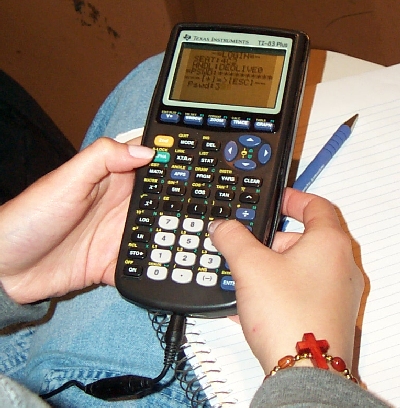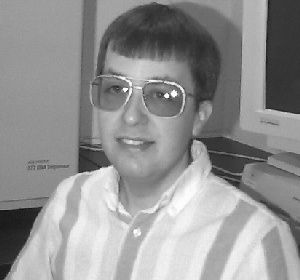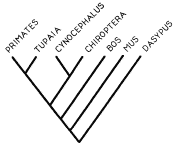Information Technology (IT) in Teaching
The latest "buzz" in improving teaching is IT.
Some efforts are aimed at replacing teachers and books,
but others are aimed at improving teacher/student interactions.
Projects of both types are being pursued within the Biology Department.
Randy Phillis, who teaches introductory biology using ClassTalk
Technology, just returned from delivering a presentation at a
Pew Center
for Academic Transformation conference on IT in teaching. At the
conference both of the aforementioned aims of IT in teaching were presented.
Randy returned with many new ideas and a reassurance that the Biology
Department is at the forefront of thinking with regard to IT and teaching.
The Massachusetts Board of Higher Education recently published a mandate
on IT in higher education. An included target is laptop ownership by
every undergraduate. While this may seem like a dream at the moment,
the Biology Department is anticipating that eventuality.
Randy Phillis and Elizabeth Connor from Biology, Steve Goodwin
from Microbiology and Adam Porter from Entomology have combined forces
to use an innovative cluster of technologies in their teaching of Biology 100
and 101. In this endeavor they are
supported by our teaching technology expert Steve Brewer and the
ClassTalk expertise developed in the Physics Education Research Group, headed
by Bill Gerace.
 Students come to class with their
personal $100 TI calculators which they plug into the ClassTalk network.
During the lecture, small student groups are given problems to solve and the
answers, accompanied by class results, are projected for the entire class to
see and discuss. Students are also encouraged via an online daily-updated
web page to read the relevant chapters in the required text prior to lecture
and to earn credits by successfully completing short online quizzes before
class. This allows class time to be spent in clarifying the information
rather than exposing students to it for the first time. In Biology
100 and 101, the use of IT does not result in
a dilution of course content; the same amount of material is covered with more
time spent clarifying concepts.
Students come to class with their
personal $100 TI calculators which they plug into the ClassTalk network.
During the lecture, small student groups are given problems to solve and the
answers, accompanied by class results, are projected for the entire class to
see and discuss. Students are also encouraged via an online daily-updated
web page to read the relevant chapters in the required text prior to lecture
and to earn credits by successfully completing short online quizzes before
class. This allows class time to be spent in clarifying the information
rather than exposing students to it for the first time. In Biology
100 and 101, the use of IT does not result in
a dilution of course content; the same amount of material is covered with more
time spent clarifying concepts.
The ClassTalk approach will be extended in spring 2002 when Elsbeth
Walker will use it to teach genetics. Genetics would seem a natural
course for this approach; it would be helpful to provide students the
opportunity to solve genetics problems with the instructor at hand to help
analyze responses and to provide reasons for the inappropriateness of certain
solutions.
Randy reports that, at the Pew Conference, courses were described in which 50 or
100 laptops were connected with wireless technology to the course hub.
If groups of two or three students were to use one computer, then classes of
200 to 300 students could be accomodated. The key to developing
IT-supplemented pedagogy is to enhance rather than eliminate the role of the
teacher.
Several other faculty have introduced IT into their courses.
Dennis Searcy has experimented with the use of an
online textbook in his Cell Biology course. This requires that every
student have access to an online computer or terminal. Currently, about
85% of UMass students own computers.
Pat Wadsworth reports that she has ceased to use paper handouts in her
400 student course, Biology of Social Issues; all visual materials are on the
course website. Use IT and save a tree!
Genes: New High Fashion on Campus?
The year 2001 marks the beginning of a new
era in which we know the entire genome sequence for several organisms,
including our own species, Homo sapiens. We are now
faced with making sense and use out of the vast assemblage of
information about our genome. Molecular biology
once pursued the understanding of gene structure and expression.
Now, the field of bioinformatics has the task of
organizing and understanding the design and evolution of the large databases we
know as genomes. The sheer vastness of the data will require new
approaches to handling databases and accessing the data therein. This
opportunity to develop new technology and methodology might be likened to the
challenge of landing a human on the moon.
One approach will be to
compare our genome architecture to that of closely and distantly related
species - not comparing gene structure but rather the
clusters and orderings of genes on the chromosomes on which they lie.
The evolution of gene patterns may teach us about the function of the
 large amount of "junk" DNA that lies between the transcribed DNA that codes for
proteins and structural RNAs. The Biology Department has joined the
cadres of scientists who will be exploring genome organization in a variety of
species.
large amount of "junk" DNA that lies between the transcribed DNA that codes for
proteins and structural RNAs. The Biology Department has joined the
cadres of scientists who will be exploring genome organization in a variety of
species.
In 1998 The University of Massachusetts Automated DNA Sequencing
Facility was established with Biology faculty member Ron Adkins as
Director.
Since its opening, the facility has applied its machinery to the
sequencing of DNA of over 200 different species. The facility services
the sequencing needs of 60 laboratories in the 5-College community.
Each year sees its usage increasing with a 6,400 sequence throughput in the
past year, representing 3.2 million nucleotide pairs identified.
Facility director Ron Adkins is interested in the deep structure of
 mammalian phylogenetic divergence as exemplified by this tree of mammalian
evolutionary branching, excerpted from one of his earlier publications, which
includes primates, tree shrews (Tupaia), flying lemurs
(Cynocephalus), bats (Chiroptera), mice (Mus), cows (Bos) and armadillos (Dasypus). Ron's current research is exploring the evolution
of the deep structure of the speciose group of mammals which includes
mice and rats. Another Biology faculty member Yin-Long Qiu uses
the facility to study plant genomics.
Microbiology Professor Derek Lovley used the facility extensively to
contribute to the Geobacter genome project. Biology courses use
the facility to provide training in the application of the tools of molecular
biology. In addition to genomics research per se, the facility is being
used by university geneticists in a variety of
ways. Geneticist Randy Phillis explains typical scenarios: "Once
we have induced a mutation in our organism of choice, we can identify the
locus of the mutation and sequence the gene. Then we can compare that
gene to the worldwide database of gene sequences and perhaps find homologous
genes whose properties have been identified previously. This gives us
clues to how our gene works. Second, we can engineer a mutation
in a known gene in order to explore the effects of such a mutation. The
sequencing facility can quickly allow us to check that our engineering
created the mutation we desired."
mammalian phylogenetic divergence as exemplified by this tree of mammalian
evolutionary branching, excerpted from one of his earlier publications, which
includes primates, tree shrews (Tupaia), flying lemurs
(Cynocephalus), bats (Chiroptera), mice (Mus), cows (Bos) and armadillos (Dasypus). Ron's current research is exploring the evolution
of the deep structure of the speciose group of mammals which includes
mice and rats. Another Biology faculty member Yin-Long Qiu uses
the facility to study plant genomics.
Microbiology Professor Derek Lovley used the facility extensively to
contribute to the Geobacter genome project. Biology courses use
the facility to provide training in the application of the tools of molecular
biology. In addition to genomics research per se, the facility is being
used by university geneticists in a variety of
ways. Geneticist Randy Phillis explains typical scenarios: "Once
we have induced a mutation in our organism of choice, we can identify the
locus of the mutation and sequence the gene. Then we can compare that
gene to the worldwide database of gene sequences and perhaps find homologous
genes whose properties have been identified previously. This gives us
clues to how our gene works. Second, we can engineer a mutation
in a known gene in order to explore the effects of such a mutation. The
sequencing facility can quickly allow us to check that our engineering
created the mutation we desired."
The Sequencing Facility is an indicator of the serious commitment the
University and its biology faculty have made to support modern genomics
research and teaching.